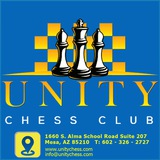A good decision.
Accepting the sacrifice with 20.Nf6+ exf6 21.Rxd8 Rxd8 22.exf6 Bxf6³ leads to a position where the white king is in serious danger, whilst the black pieces are well coordinated.
Accepting the sacrifice with 20.Nf6+ exf6 21.Rxd8 Rxd8 22.exf6 Bxf6³ leads to a position where the white king is in serious danger, whilst the black pieces are well coordinated.
Black has satisfactorily resolved the problems he faced and has developed his pieces. The game is equal.
Unity Chess Club
Hein Donner Vasily Smyslov Havana 1967 Black to move
The white queenside pawn structure is very weak and the b3- and b4-squares are particularly vulnerable. This promises Black good piece play, and he also controls the d-file for the moment. On the other hand, he cannot mobilize his pawn majority.
White would like to play f2-f4 followed by e4-e5 or f4-f5, depending on circumstances, but he may not have enough time for this. His first task is to fight for the d-file.
Black’s main plan is to play ...Bc8-e6-b3 to gain control of the d1-square and therefore the d-file.
White would like to play f2-f4 followed by e4-e5 or f4-f5, depending on circumstances, but he may not have enough time for this. His first task is to fight for the d-file.
Black’s main plan is to play ...Bc8-e6-b3 to gain control of the d1-square and therefore the d-file.
A useful move that limits the activity of the white minor pieces while taking the b5-square away from the queen. The delay in manoeuvring the bishop towards b3 will not prevent it from occurring.
17...Be6 may also be good, but this allows 18.Qb5!? when after 18...Qxb5?! 19.axb5 Nc5 20.e5 the b5-pawn is not as weak as it was on a4 and the black queenside pawns are exposed.
Now it’s done. By this precise move Smyslov stabilizes his great advantage.
Keeping the e5-pawn is important in order to resist. This mistake ends the game.
The a4-pawn is in a very bad way and this is on top of the material deficit, so White chose to resign.
Unity Chess Club
Luis Piazzini Carlos Guimard Necochea ch-ARG m 1938 Black to move
White has just played 30.h4? with the likely intention of continuing 31.g5 when he would gain a large space advantage and lasting pressure. This involves calculating a simple variation that gains an exchange for a pawn and evaluating the resulting position.
White has an exposed king, his rooks lack prospects and he has weak pawns on e3 and h4, or elsewhere in case of a modification of the structure. The black knight has excellent squares on e4 and f5 and the g4-pawn is annoying. Without calculating anything we can see that White cannot be better and is probably much worse. Thus, to have played 30.h4 in a superior position was a big strategic mistake.
Threatening a check on e4. 37...Ne4+? immediately is no good because of 38.Rxe4.
